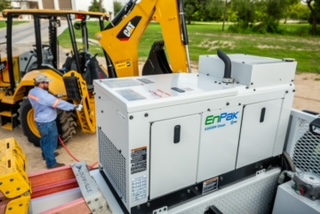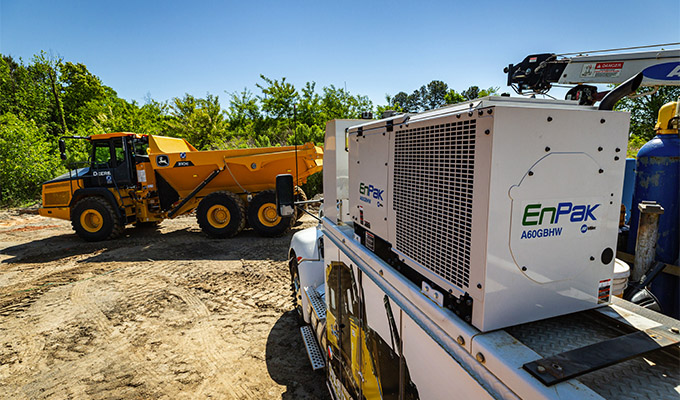It may take some work to convince your organization that investing in a premium product is the best solution. Here’s how.
FLEET BUDGET BUY-IN
It can be stressful figuring out how to balance competing metrics when specifying a new work truck. You want to make sure your employees have the appropriate tools and a safe and comfortable work environment. But your company also wants to stretch the budget as far as possible.
Savvy fleet professionals recognize that sometimes an initial higher acquisition cost can save money over the life of the asset. Investing in a high-quality product can deliver results above and beyond the norm. This is thanks to technologies that help improve jobsite safety, save fuel and maintenance costs, and optimize efficiency.
Auxiliary power units (APUs)—or engine-driven all-in-ones—are an effective way to reduce total costs; however, they do sometimes require spending more upfront. It may take some work to convince the rest of the organization that investing in a premium product is the best solution.
Learn how to justify and champion a premium purchase with three different stakeholders in your organization: your budget approval team, the service manager, and your service techs.
REDUCING COST OF OWNERSHIP
 Stakeholders who approve your budget focus on the big picture and want to understand how this decision will impact other parts of the organization. Go in armed with total cost of ownership stats and all the benefits they’ll get from your premium solution.
Stakeholders who approve your budget focus on the big picture and want to understand how this decision will impact other parts of the organization. Go in armed with total cost of ownership stats and all the benefits they’ll get from your premium solution.
It’s important to understand the financial impact of truck setup and how it affects other parts of the organization. While the financial stakeholders may balk at a higher sticker price, it’s only part of the story. The total cost of ownership must also include the cost of maintenance, fuel, and downtime over the life of a truck.
Generally, a PTO system may come with a lower upfront cost compared to a truck with an APU. The initial savings is usually eliminated by the expenses associated with the additional chassis engine hours and run time needed to operate and maintain the PTO system. A PTO setup can require 75% more truck engine run time on a jobsite. This increases the risk of downtime, since high engine hours at low RPMs can quickly clog the diesel particulate filter (DPF) and force the truck engine into a regeneration cycle. In addition, the more a truck engine runs the more frequently it requires maintenance, which drives up service costs.
It’s also important to factor in fuel costs. To run a PTO system, the work truck itself needs to be running. On average, this wastes 34% more fuel. All-in-one systems allow operators to shut off the truck—which usually has a much larger engine—and run only the all-in-one engine. This results in much better fuel economy. Also, if a PTO truck operator uses compressed air and welding or a generator power, both the truck and the welder/generator will run, which drives up fuel expenses.
An added benefit to APU-style solutions versus PTO is the potential for higher value of an asset at the end of its service life or longer replacement cycles. Reducing engine hours may allow an organization to keep its trucks in service for a longer period of time. Lower engine hours combined with an auxiliary power unit can bring higher resale value.
GETTING SERVICE MANAGERS ON BOARD
Service managers demand and expect reliable equipment. Dealer reputation is at stake. If they have a truck that is out of service for repairs, they must reroute a service tech to respond to equipment service calls, which is inefficient and expensive. It also creates the potential for longer response times to customers. That’s where your recommendation for an APU solution comes in.
An APU can help decrease the time and money spent on unplanned repairs or increased maintenance cycles by reducing how much the truck engine runs.
In many cases once a fleet purchases a vehicle, the budget responsibility goes to the service department. The service department budgets for routine and preventive maintenance. However, unplanned repairs or increased maintenance cycles due to high chassis engine hours are difficult to budget for and erode the bottom line. Because of the high number of low RPM or idle engine hours, PTO trucks tend to require more routine maintenance and have a higher risk of unplanned repairs and downtime—averaging 54% more in maintenance costs compared to trucks with APUs. Unplanned repairs make it difficult for financial teams to accurately budget for expenses.
In addition, there are other costs associated with this downtime that are hard to quantify. These include lost service revenue opportunities for as long as a vehicle is out of service, costs associated with not being able to meet customers’ needs or expectations, and costs related to the inefficiencies of rerouting other technicians to meet workload demands. An APU can help address all of these challenges by reducing truck engine run time and extending time between maintenance periods.
Excessive engine idling can also affect warranty coverage. Idle hours count as engine hours, which measure how much an engine has run since it was manufactured. OEMs typically measure warranties in engine-run hours rather than miles traveled. Adding up idle hours in engine hours can void the powertrain warranty faster than anticipated.
Service managers and fleet managers should communicate to understand the costs of an asset over its life cycle.
CHANGE MANAGEMENT WITH TECHNICIANS
Service techs look for tools and products that make them more efficient and better able to respond to their customers while also offering a safer, more comfortable work environment.
It’s important that service technicians have all the tools and parts necessary for the job. Training them on how to use the tools to maximize efficiency is also important. Outfitting a truck with high-quality tools and truck setup is important. It can also play a role in getting technician buy-in for new equipment or technologies.
An APU can help save space on the truck, so technicians have more room to carry other tools. A system with remote capabilities also reduces the need for the technician to climb in and out of the truck. As a result, the technician can be more efficient and work safer.
Air compressor quality is also important, as operators use this equipment frequently and need enough air for the job. Reciprocating compressors often cannot provide enough air to keep up with larger impact guns. There are many examples of technicians waiting for an air compressor to keep up, especially when dealing with heavy equipment.
Some APU solutions also help reduce jobsite noise, which benefits technician comfort and safety. An auxiliary power unit that includes auto start and stop technology means that when a technician doesn’t need power, both the truck chassis and the APU engine are off. This saves fuel and reduces noise. Similar benefits result when the APU includes technology that adjusts engine speed to the load so the machine can run at lower RPMs as needed.
Additionally, some solutions monitor and keep the truck battery charged. This allows technicians to power truck lights, charge computers and phones, and meet other DC power needs of the truck—without turning the truck on to charge the battery.
JUSTIFY THE INVESTMENT
A premium product on trucks can help address jobsite challenges while also paying off through reduced expenses and improved efficiency.
Find more resources to help you optimize your fleet here.




